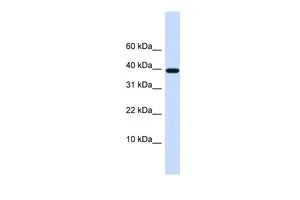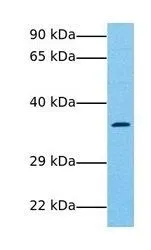
WB analysis of human B lymphoblast cells using GTX46674 LECT1 antibody at 0.2-1microg/ml.
LECT1 antibody, N-term
GTX46674
Overview
- SupplierGeneTex
- Product NameLECT1 antibody, N-term
- Delivery Days Customer9
- Application Supplier NoteWB: 0.2-2.5 ug/ml. *Optimal dilutions/concentrations should be determined by the researcher.Not tested in other applications.
- ApplicationsWestern Blot
- CertificationResearch Use Only
- ClonalityPolyclonal
- Concentration0.5-1 mg/ml
- ConjugateUnconjugated
- Gene ID11061
- Target nameCNMD
- Target descriptionchondromodulin
- Target synonymsBRICD3; BRICHOS domain containing 3; CHM1; CHM-I; chondromodulin-1; chondromodulin-I; LECT1; leukocyte cell derived chemotaxin 1; leukocyte cell-derived chemotaxin 1; multiple myeloma tumor suppressor 1; MYETS1
- HostRabbit
- IsotypeIgG
- Protein IDO75829
- Protein NameLeukocyte cell-derived chemotaxin 1
- Scientific DescriptionThis gene encodes a glycosylated transmembrane protein that is cleaved to form a mature, secreted protein. The N-terminus of the precursor protein shares characteristics with other surfactant proteins and is sometimes called chondrosurfactant protein although no biological activity has yet been defined for it. The C-terminus of the precursor protein contains a 25 kDa mature protein called leukocyte cell-derived chemotaxin-1 or chondromodulin-1. The mature protein promotes chondrocyte growth and inhibits angiogenesis. This gene is expressed in the avascular zone of prehypertrophic cartilage and its expression decreases during chondrocyte hypertrophy and vascular invasion. The mature protein likely plays a role in endochondral bone development by permitting cartilaginous anlagen to be vascularized and replaced by bone. It may be involved also in the broad control of tissue vascularization during development. Alternative splicing results in multiple transcript variants encoding different isoforms. [provided by RefSeq, Jul 2008]
- ReactivityHuman
- Storage Instruction-20°C or -80°C,2°C to 8°C
- UNSPSC12352203

